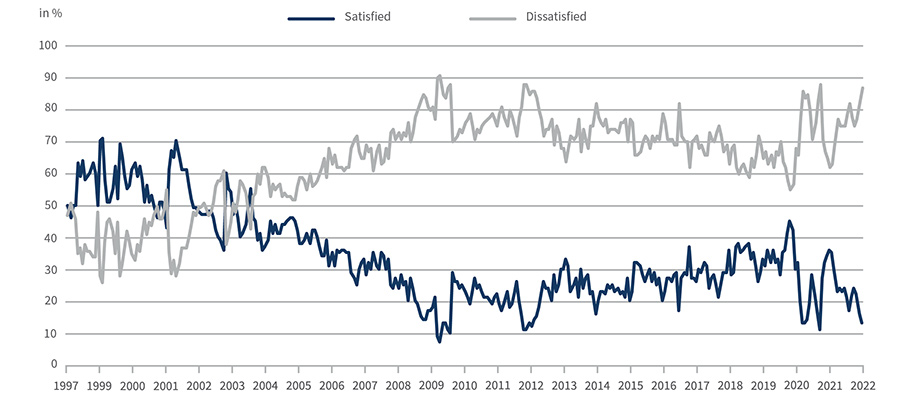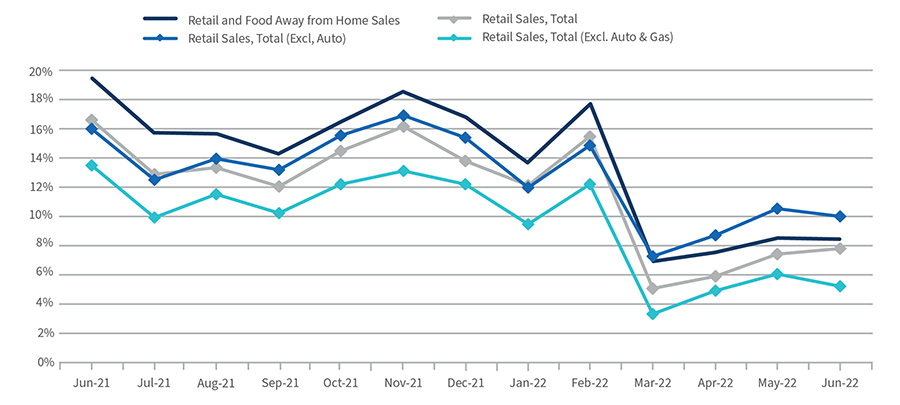Americans Are Overwhelmingly Dissatisfied with the State of Things — That’s Nothing New
-
August 22, 2022
DownloadsDownload Article
-
More than ever, the news media likes to remind viewers and readers how unhappy and divided most Americans have become, usually presented as brief news stories or passing mentions referencing various public opinion polls on the topic. There are several respected pollsters that regularly ask Americans some form of the question, “How are things going generally?” or “Is the country on the right or wrong track?” — deliberately vague and open-ended phrasing that allows respondents to attach any cause to their feelings, be it economic, political, or social, without explicitly providing their reasoning.
And it’s true; a vast majority of Americans are dissatisfied with the way things are going these days, according to most polls that ask this type of question. 1 What’s not disclosed or discussed in any stories on these survey findings is that it has been this way for a long time, nearly the entirety of this century. Consistently, a large majority of Americans have been dissatisfied with the way things are going for over 20 years, according to polling data from Gallup (Exhibit 1) and NBC News. Such longstanding discontent would rule out facile explanations, such as the rise of the social media echo chamber, the Trump or Biden presidencies, or the COVID-19 episode. What exactly is driving such widespread discontent?
The lopsided responses to this question must necessarily transcend strict political affiliations and considerations; that is, it would be practically impossible to have, say, three-quarters of all respondents claiming to be dissatisfied if responses were dictated primarily by political considerations in a country that is nearly evenly divided politically. However, political considerations certainly do influence these survey responses, so one can only conclude that most Americans are dissatisfied for differing reasons that are likely shaped by respondents’ political leanings. So red or blue, Americans are likely divided on the reasons for their discontent, but overall, America is a dissatisfied nation — whatever that exactly means — and has been for quite a while, irrespective of events of the moment.
Gallup has the most robust data set for this type of question, for which it provides just three answer choice options, “Satisfied,” “Dissatisfied” or “Unsure” — the last of which almost nobody chooses. (Other similar polls from Quinnipiac University and CNN, provide more answer choices, such as “Somewhat…” and “Very…”, and don’t provide response data history prior to 2000.) Gallup has been fielding this survey question monthly for several decades, and its response history reveals several noteworthy findings:
Respondents haven’t been satisfied overall since the late 1990s: The last time a majority of Gallup poll respondents consistently said they were generally satisfied with the way things were going was in the late 1990s. This period featured strong economic growth and jobs gains, a not-so-squeezed middle class, huge workplace productivity gains driven by IT and other tech-driven advances, cheaper consumer goods driven by the North American Free Trade Agreement, an inflating stock-market bubble (especially for tech and dot-com stocks) that defied former Federal Reserve Chair Alan Greenspan’s warning about irrational exuberance in 1996, 2 very cheap gasoline prices (around one dollar per gallon, for those too young to remember), and the last time the U.S. federal budget ran surpluses. Generally, the mid-to-late nineties are still widely considered an idyllic period for the U.S. economy, despite their excesses and the challenges they later presented.
Discontent began to set in early in the early 2000s: Respondents’ dissatisfaction began to increase in early 2001, which corresponded with the bursting of the stock market bubble and an accompanying recession that year. The attacks of 9/11 momentarily caused a patriotic surge of satisfaction, but it wore off quickly, and the start of the Iraq war in early 2003 coincided with an uptrend in dissatisfaction that has continued virtually uninterrupted to this day. The prevalence of dissatisfaction grew steadily throughout this first decade of the century, well before the housing bubble burst, energy prices soared, and the Great Recession began in 2008. Even during the economic sweet spot of the decade from 2004 to 2007, when financial markets rallied and home prices soared, a growing percentage of respondents expressed dissatisfaction with the state of things (Exhibit 1). Dissatisfaction peaked at 91% in October 2008 when the global financial crisis set in following the demise of Lehman Brothers the previous month.
A large majority of respondents have remained dissatisfied since 2008: Dissatisfaction remained very high through 2011, as the jobs recovery from the Great Recession was exceptionally slow in developing and didn’t really kick in until 2012. Many Americans were resentful that the federal response to the financial crisis “saved Wall Street” but didn’t save millions of lost jobs in that time. Apparently, much of that resentment has lingered. The last decade has seen meandering levels of high dissatisfaction even as the Federal Reserve engineered a prolonged period of low interest rates accompanied by strong corporate earnings growth and outsized financial market returns. It was during this decade that the notion of a healthy corporate sector and strong markets detached from the financial woes and insecurities of average Americans became a popular discussion topic. Incredibly, the percentage of monthly Gallup poll respondents saying they are dissatisfied with the ways things were going has averaged 74% since 2008 and 71% since 2012.
Dissatisfaction has moved higher since 2020: Not only are most Americans dissatisfied, but the percentage who say so has increased further since 2020. Two events likely contributed to this latest leg up, namely the initial effects of COVID-19 in mid-2020, and the assault on the United States Capitol Building on January 6, 2021, coupled with a surge in new COVID cases and deaths that same month, both of which saw further spikes in dissatisfaction shortly thereafter. The percentage of dissatisfied respondents is currently in the mid-80 percent range, close to previous highs reached in 2008-2011. Indeed, an overwhelming majority of Americans are dissatisfied with the way things are going today.
Exhibit 1 – In General, Are You Satisfied or Dissatisfied With the Way Things Are Going in the U.S. aat This Timet This Time

Source: Polling Report.com and Gallup Poll
These Gallup survey responses are not an outlier; NBC News has also conducted a similar poll covering this same period (Is the Nation Generally Headed in the Right Direction or Is It on the Wrong Track?) that has produced very similar results during this 25-year time span.
Much like last month’s discussion on record-low consumer sentiment, economic facts on the ground don’t seem to support the pessimism implied by the high percentage of dissatisfied Americans. Certainly the U.S. economy is confronting adversity it hasn’t experienced in decades, namely high inflation and rising interest rates, but the unemployment rate is exceptionally low, job creation remains robust, and consumer spending growth through June has stayed fairly strong (Exhibit 2) despite these headwinds.
Unlike the consumer sentiment survey, which queries respondents only on economic conditions and personal finances, the “Right Track/Wrong Track” type of question leaves the door open to non-economic considerations, so other issues, like rising crime, extreme weather events and global warming or threatening geopolitical events undoubtedly influence these responses.
So the next time you hear a news story about how many Americans say the country is on the wrong track, just remember that it has been this way for a long time and this phenomenon isn’t likely determined by current events or recent developments. Perhaps it’s more of a malaise or cynicism that shapes the way many Americans interpret all events. The good news, if it can be called that, is that there is little room for dissatisfaction to get much worse. Years of mounting financial struggles for much of the middle class and widening wealth and income disparities this century have likely shaped such discontent, but that topic is beyond the bounds of this discussion.
It’s hard to dismiss such pervasive dissatisfaction as inconsequential, and certainly it reflects the frustrations and anxieties of many millions of Americans, but given its steady persistence for many years, it has had little discernible impact on consumer behaviors or the vicissitudes of the economy for over two decades. However, it puts a big dent in the old cliché that Americans are an eternally optimistic bunch compared to other countries. That may have been true for many decades, but most Americans consistently have been telling pollsters otherwise since this century began. Who are all these dissatisfied people? You surely know some of them.
Exhibit 2 – U.S. Monthly Retail Sales Growth (YOY)

Source: U.S. Census Bureau, Advance Monthly Retail Trade Report, June 2022
Footnotes:
1: Megan Brenan, Americans Remain Largely Dissatisfied with Direction of U.S., Gallup, March 31, 2022
2: Adam Hayes, Irrational Exuberance, Investopedia, 2022
Related Insights
Related Information
Published
August 22, 2022
 Key Contacts
Key Contacts
Global Segment Leader of Corporate Finance & Restructuring


